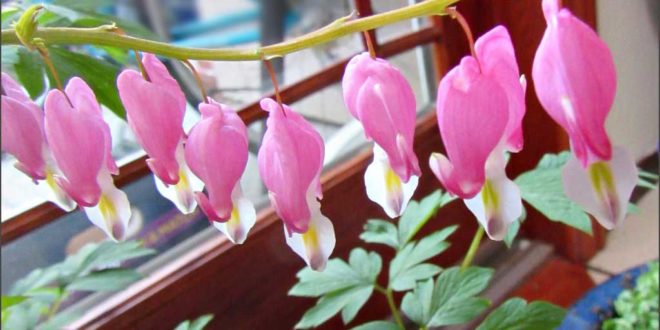The bleeding heart plant (Lamprocapnos spectabilis) has heart-shaped flowers that hang in rows on arching stems above soft, green foliage. This spring-blooming perennial has a short growing season. By midsummer, the whole plant dies back to the ground. Bleeding heart is hardy in U.S. Department of Agriculture (USDA) plant hardiness zones 3 through 9.
Growing Season
Like other herbaceous perennials, bleeding heart grows for many seasons from underground roots, but the plant’s life cycle differs from that of many other perennials. Most perennials die back at the end of the growing season, in late fall and early winter. Bleeding heart, however, dies back to the ground by midsummer, right after its blooming season. The plant remains dormant through the rest of the year and grows again in late winter or early spring. The plant takes two to five years to reach its mature height.
Flowering Season
Early in spring, or late in winter in mild climates, new shoots grow from bleeding heart’s rhizomatous roots under the soil. Rhizomatous roots are fleshy roots that store nutrients and genetic information from season to season. The green foliage grows 2 to 3 feet tall in a soft, mounding shape. By mid-spring, the flower stalks emerge above the foliage. Each flower stalk holds multiple heart-shaped flowers that hang in a row. The weight of the flowers causes the narrow stalks to arch and hang toward the ground.
Growing and Care
Bleeding heart thrives in a deep shade or partial shade area and consistently moist soil. A single application of general-purpose fertilizer in spring provides important nutrients for the plant’s growing season. Apply the fertilizer when bleeding heart’s new shoots emerge. In midsummer when the plant dies back, either leave the dead foliage in place to create a mulch layer over the rhizomes or cut back the dead foliage to tidy the garden.
Companion Plants
Prevent a big hole in the landscape when bleeding heart dies back in midsummer by mixing other foliage plants with bleeding heart. Look for shade-loving plants that remain green through the growing season or all year. Hostas (Hosta spp.) make ideal companion plants for bleeding heart. The low-growing perennials come in an array of variegated leaf patterns and colors. Hostas grow in partial to full shade and are hardy in USDA zones 3 through 9.
Ferns, such as the shade-loving Alaskan fern (Polystichum setiferum), which is hardy in USDA zones 5 through 9, grow well alongside bleeding heart.
Another companion plant is Lily of the Valley. But be cautious: all parts of this lily are toxic to pets and people.
Varieties
If you want a variation on bleeding heart’s traditional pink and white flowers, try the cultivated variety “Alba” (Lamprocapnos spectabilis “Alba”), grown for its white flowers, or add color to the landscape with “Gold Heart” (Lamprocapnos spectabilis “Gold Heart”), a cultivated variety with gold-colored foliage and rose-pink flowers. Both cultivars are hardy in USDA zones 3 through 9. The scientific name “Dicentra spectabilis” is a synonym of the scientific name “Lamprocapnos spectabilis.”
Common Name: bleeding heart
Type: Herbaceous perennial
Family: Papaveraceae
Native Range: Siberia, Japan, northern China, Korea
Zone: 3 to 9
Height: 2.00 to 3.00 feet
Spread: 1.50 to 2.50 feet
Bloom Time: April to May
Bloom Description: White/pink
Sun: Part shade to full shade
Water: Medium
Maintenance: Low
Flower: Showy, Good Cut
Tolerate: Rabbit, Heavy Shade








